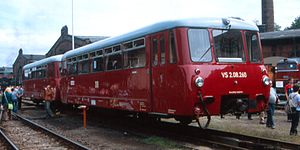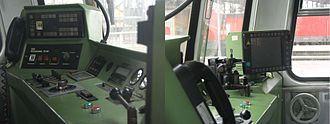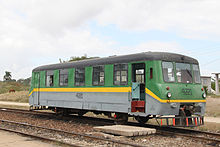DR series VT 2.09
| DR class VT 2.09 DR class 171/172 DB class 771/772 |
|
|---|---|
|
Set of LVT and LVS in the original paintwork
|
|
| Manufacturer: | VEB Waggonbau Bautzen |
| Year of construction (s): | 1957 (model) 1962–1969 (series) |
| Retirement: | until 2004 ( OBS until 2019) |
| Axis formula : | 1A |
| Length over coupling: | 13,550 mm |
| Total wheelbase: | 6,000 mm |
| Service mass: | 15.6-19.3 t |
| Wheel set mass : | 11.4-13.6 t |
| Top speed: | 90 km / h |
| Indexed performance : | Series: 180 HP = 132 kW |
| Wheel diameter: | 900 mm |
| Drive: | diesel-mechanical / hydromechanical |
| Brake: | K-P + Mg and additional brake (railcar) KP and additional brake (control car) KP (sidecar) |
| Seats: | 54 |
Rail buses of the Deutsche Reichsbahn , which were developed and produced by VEB Waggonbau Bautzen , were designated as DR series VT 2.09 (from 1970: series 171/172 ) . After the vehicles were taken over by Deutsche Bahn AG , they were referred to as the 771/772 series.
history
The rail buses, officially known as light-incineration railcars, were developed by VEB Waggonbau Bautzen from 1955. In 1959 the first two vehicles were presented and used as planned from 1962. These had a Büssing engine. In the same year six more railcars with sidecars were produced. The first series was produced from 1963 (VT 2.09.008-070). In 1965, sixteen railcars and, for the first time, control cars were built, as repositioning at the end of the line hampered operations. They were given the road numbers VT 2.09.101–116. In the course of the specialization of the works, the other series were manufactured in Waggonbau Görlitz , from 1969 73 railcars and 72 control cars, with the road numbers VT 2.09.201-273.
A special feature of the series 171.8 sidecars was that they visually carried all the preparatory work for a triple headlights. However, this was never built in and technically pointless, because as a sidecar they could not have this front lighting. The optical preparatory work with the functionless front headlights was only intended to standardize and rationalize the manufacturing process, but in the later actual control cars of the 172.6–7 series, which required real headlights and also the headlights, these headlights were only available at the ends with the control panel, but not on the side without this.
Similar to the West German Uerdinger rail buses (VT 95 / VT 98) , they were involved in the change from steam to diesel traction on branch lines . Due to the combination of the wheel base of 6,000 mm with axles that cannot be radially adjusted, a special permit was required.
The vehicles were initially put into service under the designation VT 2.09 / VB 2.08 / VS 2.07 and in 1970 they were redesignated in the 171.0 series as motor vehicles and 171.8 (sidecars) and 172.0–1 (motor vehicles) and 172.6–7 (control vehicles) . The original version of the 172 series consists of a motor vehicle with two driver's cabs and a control car with one driver's cab. There are two double-leaf folding doors on each side. The vehicles had an optical-acoustic door-closing warning system, consisting of a bell and a red warning light, which was activated before the doors were automatically closed. The later railcars received a reinforced frame, they received serial numbers from 201. A multiple and push-pull train control also for double traction was originally only available in the 172 series. Up to six cars could be driven in a group. The vehicles had Scharfenberg couplings .
The control cars of the 172.6–7 series only had a control panel on one side. The side facing the railcar only had a long bench at the end of the car, like the class 171 sidecars.
They were motorized with a six-cylinder in-line engine of the type 6VD 18/15 from VEB Elbewerk Roßlau , which was arranged in an underfloor construction. The power is transmitted via a permanently filled fluid coupling to a six-speed electric gearbox. All passages are located in this gear is engaged, they are electrically-operated friction clutches with integrated free-runs ( overrunning ) flanged to the secondary shaft. The freewheels prevented damage to the engine and transmission if the wrong gear was selected. 772 003 was used for testing purposes with an electric gearbox without freewheels. An axle reversing gear made it possible to change the direction of travel; this could be carried out at standstill by means of a pneumatic shift cylinder to which compressed air was applied via solenoid valves .
The power supply of the railcar (motor vehicle) was originally provided by a 24 V / 1.2 kW alternator in the trailer and control vehicle through an axle generator that was driven by a leather flat belt. In the course of the modernization of the series, the axle generators with their interference-sensitive drive were replaced by a central power supply, which was fed by the railcar. Even with the axle generator intact, the numerous slow-speed areas on the branch lines often meant that insufficient power could be generated to charge the batteries and operate the lighting and heating / ventilation in the side / control cars. For this reason, the railcars received two alternators, which were connected in parallel.
The engine was cooled by an underfloor cooler which was suspended under driver's cab 1 and whose fan - depending on the coolant temperature - was driven by a V-belt by a hydrostatic motor.
The passenger compartment of the railcars (VT) was heated by a cooling water-fed and an oil-fired air heater, the control (VS) and trailer (VB) were each equipped with two oil-fired air heaters for this purpose. These were controlled by thermostats so that the heating output automatically adjusted to the outside temperature.
The series (VT + VB + VS) was equipped with disc brakes on all axles, each with an internally ventilated brake disc. The railcars also had a low-hanging magnetic rail brake , which came into effect when the driver's brake valve was in rapid braking position . As a result, appropriately short braking distances could be achieved in an emergency even on seldom traveled and therefore often dirty and greasy routes.
modernization
On January 1, 1992, the railcars were transferred to the series scheme of the Deutsche Bundesbahn and were given the series numbers 771 and 772, the trailer 971 and the control car 972. In the early 1990s, many vehicles were converted. They were equipped with MESA train radios and PZ 80 ( punctiform train control ). Bright Sprelacart panels and large laminated glass windows were used in the interior . The upholstery was changed to the green fabric that was common at the time. The driver's seat, which until then had been open to the passenger compartment, was given a separating rear wall with windows and a lockable door, and the wooden desks were replaced by GRP desks in the new design. This reduced the number of seats from 54 to 40.
The engine was exchanged for the type MAN 2866 UH with 162 kW, in some cases the electric gearboxes were exchanged for fluid transmissions of the Voith Diwa D 863 type , as it is also installed in buses. The electrics were largely standardized. The EBuLa ( electronic book timetable ), which has now become necessary , has also been upgraded. Some control cars were converted into railcars by installing an engine. Two railcars used on Usedom were powered by natural gas.
The new color scheme took place in the product colors of the German Federal Railroad for local transport, pastel turquoise and mint turquoise. In particular, the replacement of the drive system enabled the vehicles to continue operating for a further inspection period.
Whereabouts
In Germany, the last regular place of work was Stendal . The 772 155 was parked here on January 14, 2004. In Heringsdorf and Zinnowitz on Usedom there are still some railcars and sidecars parked. Some of them have already been externally refurbished, including the natural gas-powered 772 201 (formerly 771 014) with sidecar 972 201 (formerly 971 014).
From January 26, 2006 to March 30, 2019, the two railcars 772 140 and 141 of the Deutsche Bahn were again in service with the RegioNetz Oberweißbacher Berg- und Schwarzatalbahn . Both railcars were modernized, equipped with closed toilet systems and were given their original Deutsche Reichsbahn paintwork. They were mainly used for special trips, but were also used in regular operation on the Schwarzatalbahn when one of the two class 641 railcars was in the Erfurt plant for maintenance. In the meantime these have been sold.
22 of the retired vehicles were sold to Cuba and Romania (16 multiple units and sidecars). However, many of the Cuban vehicles are no longer operational. Other vehicles went to Spain to Gestor de Infraestructuras Ferroviarias , a track construction company, and Julius Berger Nigeria (JBN), a subsidiary of Bilfinger . Some vehicles were sold to Brazil, where they are still in use today, but an end to use due to a lack of spare parts is in sight.
Some railcars have been kept by various railway associations in eastern Germany for special trips and tours. The “Hafenbahn Neustrelitz e. V. "and the" Ostsächsische Eisenbahnfreunde e. V. ”regularly use their railcars for special trips. The “Traditionsgemeinschaft Ferkeltaxi e. V. “owns several railcars with which an extensive program of special trips is carried out in Central Germany. The "Eisenbahnnostalgie Vogtland" regularly uses its operational railcars on the Ore Mountain View Railway and the Wisentatal Railway . The railcars are located in the historic Adorf (Vogtl) depot , and one vehicle is currently in the traditional Stassfurt depot .
Since December 9, 2012, motor coach 172 001 of Hafenbahn Neustrelitz e.V. has been in regular service on the Mirow - Neustrelitz route . V. and the motor coach 172 171 of the company Köstner rail bus trips from Chemnitz on behalf of the railway company Potsdam .
The railcar 772 342, repainted in traffic red, was on display at Leipzig Central Station for several years . In the meantime, the vehicle was sold to the "Lausitzer Dampflok Club e. V. “and received a new general inspection in April 2010 . 772 332 was also repainted in traffic red by the association and is also available for special trips.
The following railcars will be operational in 2019:
- 772 001 + 972 601: Neustrelitz port railway
- 772 342, 772 332: Lausitz Steam Locomotive Club
- 772 140, 772 141: PRESS
- 772 171, 772 132, 972 760: Traditional community piglet taxi
- 771 056, 772 155, 772 312, 772 367, 972 741: Vogtland railway nostalgia
- 772 413 + 972 502: East Saxon Railway Friends Löbau
- 772 173: Usedomer Eisenbahn GbR
- 772 345: Erfurt Railway Service
Nicknames
The railcars were quickly given the name Ferkeltaxe , and the railcars were also known as blood bladder, sandman train or owl .
gallery
Individual evidence
- ↑ For the last time a piglet between Rottenbach and Katzhütte in the plan service , LOK report from March 30, 2019, accessed on June 24, 2019.
- ↑ arte.tv: By train through Cuba . Broadcast on February 27, 2013, 4:00 p.m.
- ↑ https://www.youtube.com/watch?v=zymsK2WZ3dk (Video "Ferkeltaxe --- die Geschichte", seen on July 6, 2020)
- ^ SWR television railway romance
- ↑ C. Much, F. Brechler, Kai-Uwe Thiessenhusen: LandesBAHN - Mecklenburg-Western Pomerania - KBS 173 Neustrelitz - Mirow . In: Bahn-Report . No. 2 , 2013, p. 35 .
- ↑ The farewell to the "piglet tax" is imminent . In: Berliner Zeitung , February 19, 2014.
- ↑ Wolfgang Herdam - photo motif piglet taxi . Book presentation on the Herdam Fotoverlag website, accessed on February 19, 2014
literature
- Bernd Friedrichs, Andreas Stange: The light-combustion railcars of the Deutsche Reichsbahn . EK-Verlag, Freiburg 2010, ISBN 978-3-88255-231-7 .










